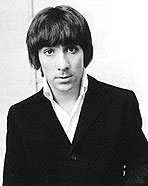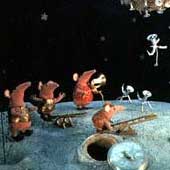Lunarcentrism
The theory of lunarcentrism--the idea that all the planets and objects in space orbit around the moon instead of the sun--is backed up by logical thought and scientific facts. This theory seems to have low popularity within the scientific community, many of whom believe that the Earth, and the moon; and many other planets, asteroids, and the like, orbit the Sun (Heliocentric means that the sun is at the centre of the solar system.)
What have the scientists at NASA been hiding from us? Obviously they know of this theory because they have sent people to orbit the moon. It doesn't take a rocket scientist, therefore, to deduce that they are hiding something from us. Could it be that they have proven scientists (like Galileo and Kepler) wrong? Could they be trying to cover that the basis of their scientific knowledge at NASA has been wrong?
One might think that the idea of the moon being the centre of the solar system is an absurd idea. They refer to those who believe in the theory of Lunarcentrism as "Lunatics." But we must question our entire model of the solar system: How did they come up with this model, so commonly shown to young children as the set-in-stone way to picture the solar system? They looked up in the sky, and created this model of the solar system. But it doesn't account for some anomalies in our Universe.
We may be "Lunatics," but we are not lunatics in the sense that is usually meant by the word. Our theory is backed up by logical thought and scientific facts.
Firstly, one must understand Newtonian mechanics: a fancy phrase to describe physics principles about motion, and especially the force of gravity. For a greater understanding of Newton's laws of motion, see any physics textbook or search on the internet.
The Physics behind it: Basics, reviewed.[edit]
"mass" vs. "weight" Force depends on mass and acceleration The force of gravity depends on the mass of the two objects, and the distance between them.
We will be concerned with gravity, but first we must define mass as opposed to weight. Most people use the terms "weight" and "mass" interchangeably, which is perfectly OK to do in most contexts. The term weight is actually the force of gravity pulling you towards the earth, and the term mass means how much stuff is in your body. On Earth, these values are the same, so that saying "I weigh 55 kilograms" is understood to mean that your mass is 55 kilograms (kg).
Weight is essentially the force of gravity pulling on you. Newton's second law states that Force is directly proportional to Mass and Acceleration. What this means is that how much force you feel--Measured in Newtons (N)--depends on your mass (for example 55kg,) and the acceleration. On Earth, acceleration can be caused because of gravity, and if (for example) you jump off a tall building, you will accelerate at 9.8 metres per second per second (written as or more commonly .).
The more mass you have, the more force there is.
You could be on a larger or denser planet (Density, by the way, is how massive a certain amount of something is. For example, a brick is much denser than a block of styrofoam; and the brick would have a larger mass and therefore weigh more, even though they are the same size.) If the planet had a mass of more than the Earth, then acceleration due to gravity would be more.
The more acceleration there is, the more force there is.
This relationship can be stated as:
The fishy like symbol is the Greek letter "alpha," which, in this case, means "Is proportional to." This means that as either the mass or the acceleration increases, so does the force.
The whole idea of gravity is that any two objects that have a mass (that means anything, for practical purposes.) are attracted to each other. The attraction between you and, say, that good-looking person of the gender of your choice, is so small that you don't feel it. The Earth is much more massive than this good-looking person, and it is pulling you towards it. The effects of you pulling the Earth towards you are so small that you can't feel it.
However if you and that wonderful amazing person of the gender of your choice, were alone in space, you would feel weightless. If you were close enough to each other, you might feel a force attracting the two of you together. This is the same force that pulls you to the Earth, and the same force that keeps the Earth from falling out of its orbit around the Sun.
This force depends on three things: The more massive you are, the more force there will be. The more massive the other person is, the more force there will be. The closer together you are (the LESS distance between you), the more force there will be.
This force is said to be proportional to the masses of the two objects: As the masses increase, the force increases. It is also said to be "inversely proportional to the square of the distance between the objects." This means that as the distance ("") between the objects INCREASES we see a DECREASE in the force (move farther away and there is less force.) The catch is (and this is very important for the theory of Lunarcentrism,) that as you move farther away from the object, the force decreases by the distance squared. () If you doubled your distance, the force would change by a factor of (). This is called the inverse square law.
The Force of Gravity () is therefore proportional to (the first mass) and (the second mass.) and (one, divided by the square of the distance between.)
This can be shown as:
Applying Physics to the Moon-Centred Solar System[edit]
First of all, the moon and the sun are both relatively close to us, in cosmic terms (compared to the Universe.)
Look up at the sky (but don't look directly into the sun, if you have a digital camera DO NOT LOOK THROUGH THE VIEWFINDER just aim your camera in the general direction of the sun and take a picture.) Then take a picture from the same spot, looking up at the moon. You can see that they look approximately the same size.
The sun is, of course, farther away than the moon so therefore is bigger than the moon even though they both look the same size from here. However, the moon is made out of rocks, and rocks have a large mass and are very dense. The sun is made out of hydrogen and helium--the two lightest gases in the Universe. (Think Helium balloons, they are lighter than air so they float.)
Think back to the Inverse Square Law. If something is farther away, the force decreases by the square of the distance. So if (for example) the sun were four times more massive than the moon, and four times as far away, it would only have four sixteenths (one quarter) of the force that the moon has. Combine that logic with the fact that the Moon is a lot more dense than the sun, and we have a case to argue that the force on the Earth by the moon is more than the force by the Sun.
So, without delving into orbital mechanics and complicated formulae that some aerospace engineers use, it is safe to say the following: if the moon exerts more force on the Earth than the Sun does, the Earth can't possibly orbit around the Sun. It must orbit around the Moon.
Paradigm Shift[edit]
This Lunarcentric theory is not widely known. It is not accepted by many scientists, because they have always been taught that the Earth orbits the sun--without being given any insight into other theories. This can be a controversial topic: it has been believed for a long time that the Earth orbits the sun.
People will choose not believe that the Solar system is any way different than they have been told all their life. (Look at the way they are thinking, when the International Astronomical Union decided to call Pluto a "dwarf planet" instead of a "planet.") Imagine how people would feel if the physics they thought to be true, was turned upside down.
A recurring argument against Lunarcentrism, is that people have been sent to the Moon and back. Probes have been sent to all the other planets to photograph them. This could not have possibly been done without precise calculations of the movement of the planets--being able to predict where the planets will be when the probe reaches them--and such.
It is one of the United States' best kept secrets: Even Kennedy didn't know that the aerospace engineers were taking into account Lunarcentricity in their plans to put a man on the moon by the end of the 1960's. The public sector is not allowed to go into space, because if they did they would discover soon enough that the heliocentric solar system is untrue. Before working at NASA, or even doing an aerospace engineering degree, one must sign a legal document saying that they will never disclose this information. Even during the Cold War, when there was not much contact between the Soviet Union (Now Russia) and the United States, they had diplomatic enough relations to agree to keep it quiet. You might call it a conspiracy.
About the astronauts, engineers, and everyone who works on a mission into space: They have a hard job, and add to that difficulty by calculating everything by a completely different set of data than the average person would suspect. They keep it under a veil of secrecy--even if someone smart saw their data, it's all in feet and pounds and cumbersome units that don't make much sense. If you think about it, it's amazing: No wonder anything else "doesn't take a rocket scientist to figure out."
What Can You Do?[edit]
You now know the truth.
What can you do? Show your support for this theory by organizing an event. Celebrate National Lunarcentrists Day. Join the Facebook group "Lunarcentrists Anonymous." Make your voice heard, because together we can make a difference.
Free things You can Use[edit]
As anthropologist Margaret Mead said: "Never doubt that a small group of thoughtful, committed citizens can change the world. Indeed, it is the only thing that ever has."
Sources[edit]
Facebook | Lunarcentrists Anonymous.













